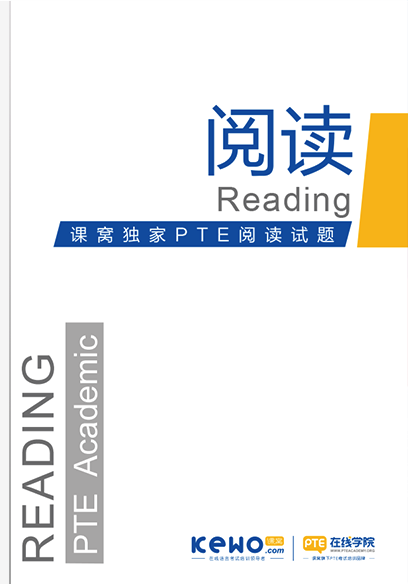在面对大篇幅的满是学术类单词的阅读时,很多小伙伴们就充满了恐惧,其实PTE的阅读是可以遵循一定的技巧的,有一些PTE考试文章小伙伴们应详细阅读某一部分的内容,而有些文章小伙伴们应专注寻找某些有用字眼。不管是什么考试正确的时间分配往往可以帮助考生在考场上最大限度的发挥出属于自己的实际水平,并且还能提高自己的整体正确率。对于PTE阅读来说合理的时间安排从原则上来讲的话是20分钟一篇。
A Humble Fish with a Colorful Edge
小鱼眼中的颜色似乎更多姿多彩
Hundreds of millions of years ago a humble fish swam in the lakes and rivers of the supercontinent Gondwana. Eventually Gondwana broke apart, becoming the continents we know today. And the descendants of that fish, now called cichlids, continue to swim the fresh waters of both Africa and South America.
数亿年前,一条卑微的小鱼在冈瓦纳大陆的湖泊和河流中游动。然而最后冈瓦纳分裂,变成我们今天所知的大陆。这条鱼的后代,现在被称为“丽鱼科鱼”,继续在非洲和南美洲的淡水中游动。

Cichlids have some of the most incredible visual systems known. Humans have genes that code for three different types of visual pigments, called opsins. Cichlids have seven.
丽鱼科鱼身上有一些已知的最不可思议的视觉系统。人类有三种不同类型的视觉色素代码的基因——“视蛋白”。而丽鱼科鱼身上却有7种。
"But what is interesting within cichlids, which is this group of very diverse fishes, is that they can express different sets of these seven genes. So they only express three typically, but different species express different groups of these seven genes."
“然而有趣的是,丽鱼科鱼这种非常与众不同的鱼类能够通过这七种基因表达出不同的集合。虽然它们只会表达出三种典型的集合,但是不同种类的丽鱼科鱼会将这七种基因表达出不同的三种集合。”
Biologist Daniel Escobar-Camacho, from the University of Maryland in College Park.
来自马里兰大学学院公园分校的生物学家丹尼尔·埃斯科瓦尔·卡马乔说道。
"So for example, we have opsin genes that code for the blue, green, and red opsin…whereas cichlids have genes that are sensitive to UV, violet, blue, blue-green, green, light green, and red."
“举例来说,我们的视蛋白基因代码是蓝色、绿色和红色的视蛋白……而丽鱼科鱼的基因则对紫外光、紫色、蓝色、蓝绿色、绿色、亮绿色和红色敏感。”
But selection pressure has kept only some of those genes intact.
但是选择压力只保留了其中某些基因的完整性。
African cichlids, whose visual systems are well studied, evolved in fairly clear, calm, blue lakes with plenty of sunlight. And it was known that they’ve maintained the genes for seeing short wavelength light, at the blue end of the spectrum. But their South American counterparts live in the murky waters of the Amazon River basin, bathed mostly in reds and oranges.
研究人员对非洲的丽鱼科鱼的视觉系统进行了很好的研究。这种鱼在拥有大量阳光的、非常清澈、平静的蓝色湖泊中生长发育。据悉,它们还保留着能够看到光谱蓝端的短波光的基因。然而它们生活在南美亚马逊河流域的浑浊水域中的同胞们则更多地沐浴在红色和橙色光线中。
Escobar-Camacho analyzed DNA from three different Amazonian cichlids: the freshwater Angelfish, the Discus, and the Oscar, all of which are also popular in home aquariums. He discovered that each species has completely lost at least one of the seven opsin genes, and some have even lost two. But they've each lost different genes.
埃斯科瓦尔·卡马乔分析了来自亚马逊河流域的三种不同的丽鱼科鱼的基因:淡水神仙鱼、野生七彩神仙鱼和奥斯卡鱼——它们都在家庭水族养殖中很受欢迎。他发现,这三种鱼中每一种都至少已经完全失去了7种视蛋白基因中的一种,有些甚至失去了两种。但是它们各自失去的都是不同的基因。
“What is interesting is that they are expressing genes in the retina that allow them to be long wavelength-sensitive. And this is in concordance with the light environment in Amazon waters, because Amazon waters transmit long wavelengths best.”
“有趣的是,他们在视网膜上表达的基因使它们对长波光敏感。而这恰好与亚马逊水域的光线环境是一致的,因为亚马逊流域传输得最好的就是长波光。”
In other words, Amazonian cichlids were most sensitive to red and orange light, which makes sense because Amazonian rivers filter out most of the blues and greens. The results are in the journal Molecular Ecology.
换言之,亚马逊的丽鱼科鱼对红色和橙色的光线最敏感,而亚马逊河恰好过滤掉了大部分的蓝色和绿色光线。该研究结果发表在《分子生态学》杂志上。
The finding is consistent with an idea called the "sensitivity hypothesis," which holds that a color visual system evolves by adapting to the dominant wavelengths of light in the environment. In other words, what you get is what you see.
这一发现与一种名为“敏感性假说”的观点相一致。该理论认为,色彩视觉系统是通过适应环境中占主导地位的波长的光而进化的。换句话说,环境给了你什么你就会看到什么。
以上就是PTE阅读练习内容了,如果还想获得更多PTE写作题型和PTE写作技巧以及PTE写作模板和PTE写作真题及PTE写作要求,或者想要了解更多的少儿PTE3e,少儿PTE考试,深圳PTE培训,我们也会继续为大家带来更多干货!











